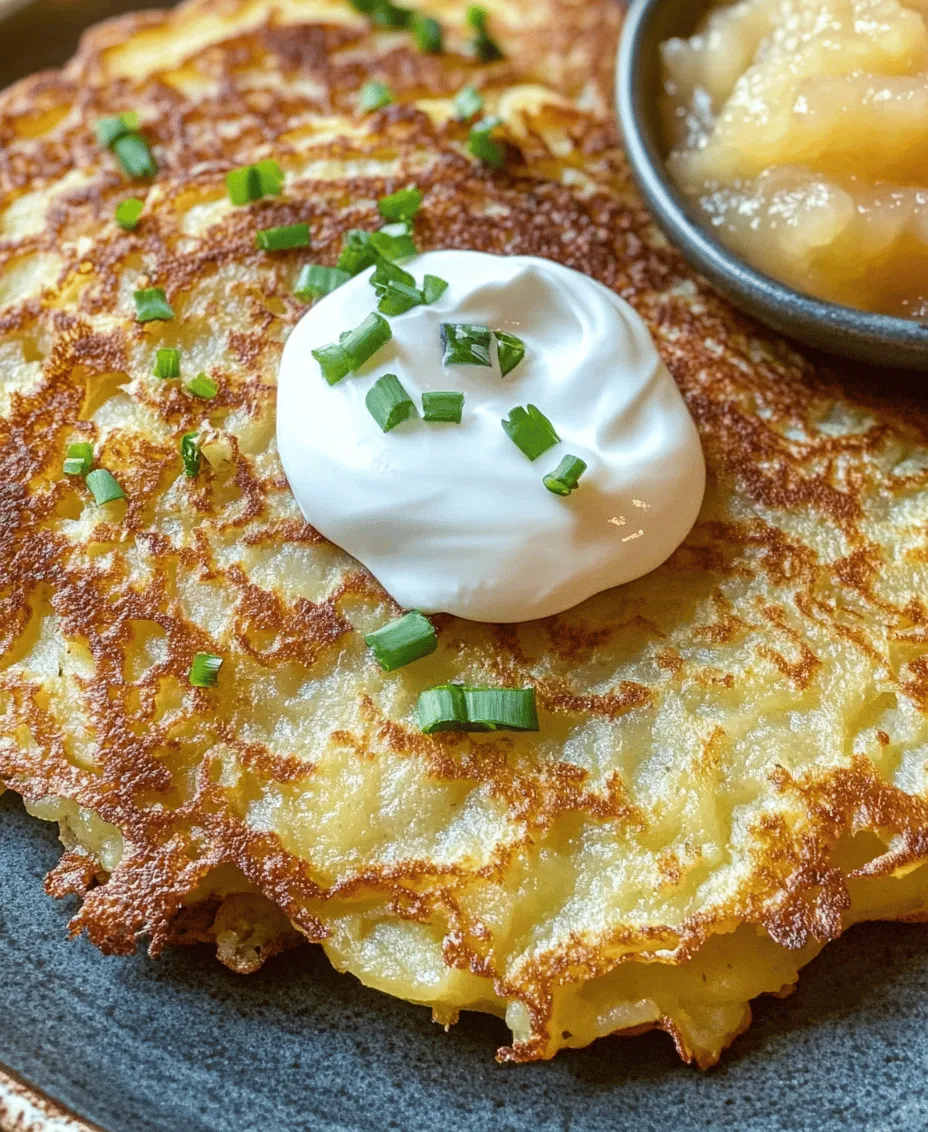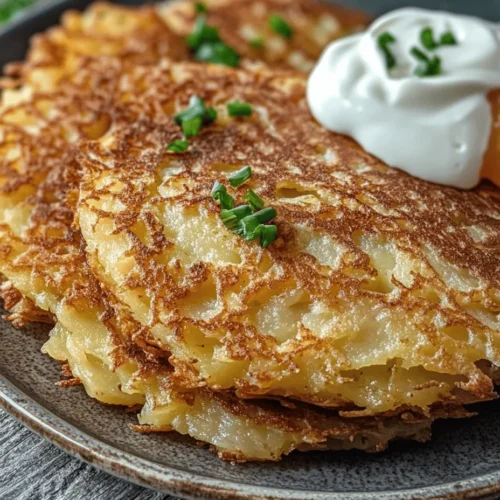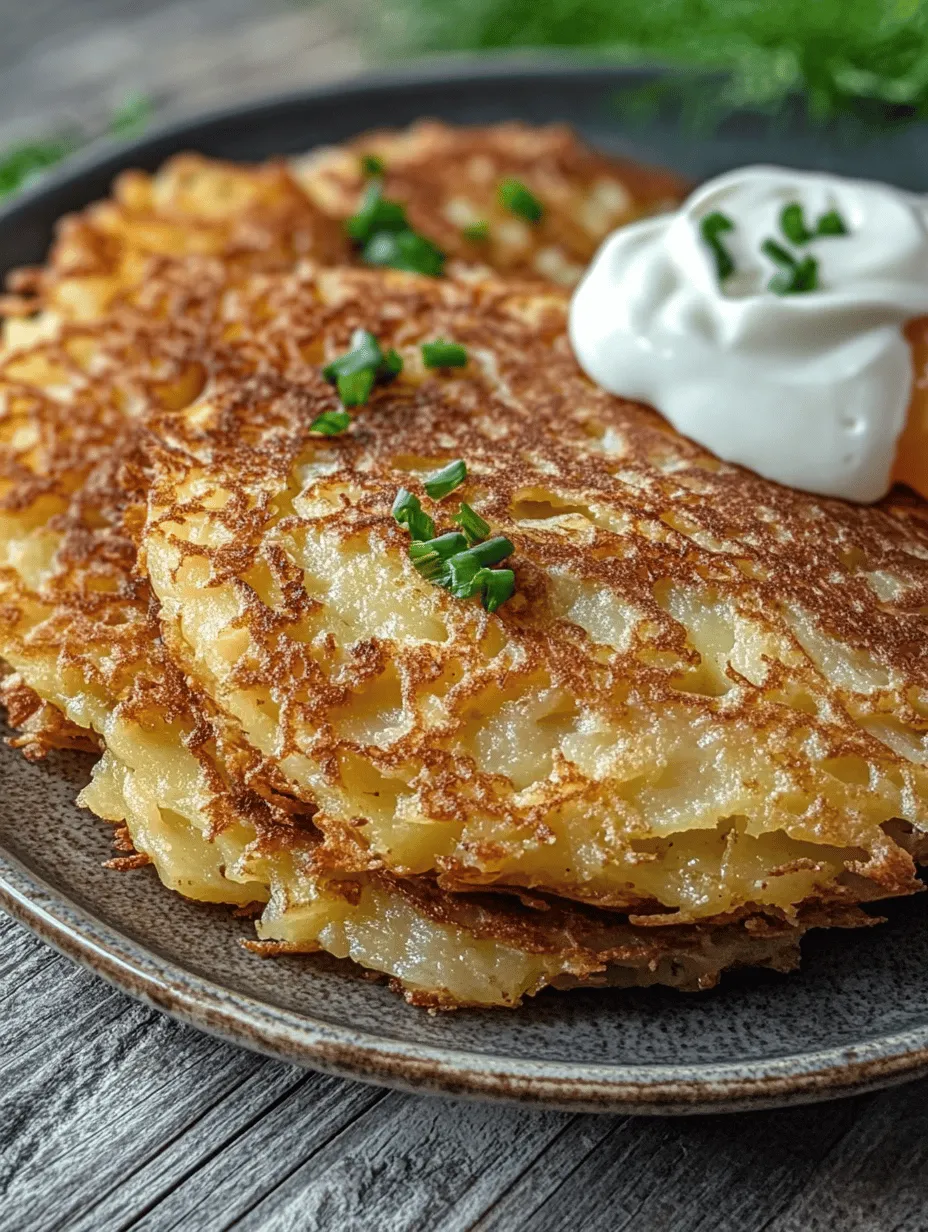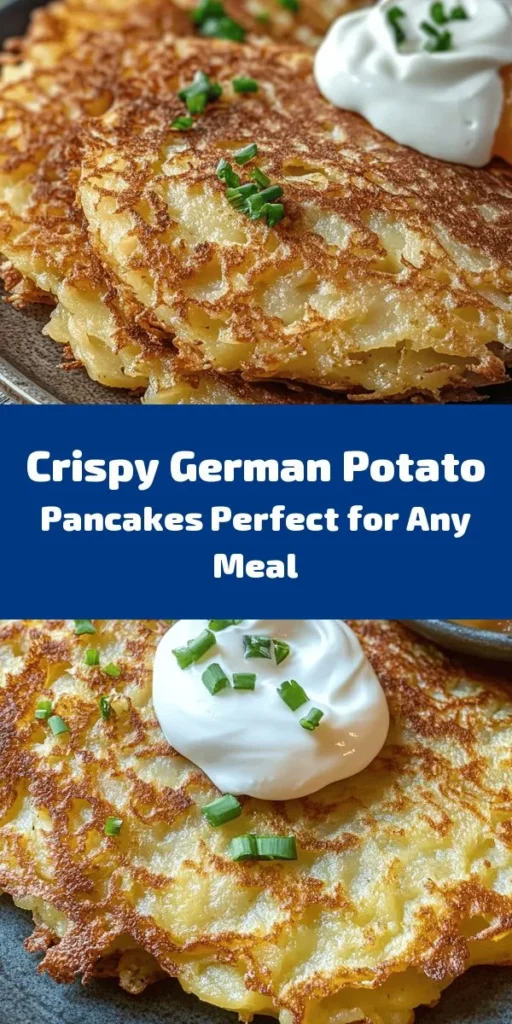Introduction
If you’re on the hunt for a dish that embodies comfort, tradition, and versatility, look no further than German potato pancakes, affectionately known as “Reibekuchen” or “Kartoffelpuffer.” This beloved dish has its roots deeply embedded in German cuisine, where it has been enjoyed for generations. Often found at festive gatherings, Christmas markets, and family dinners, these pancakes are more than just a meal; they are a celebration of culture and culinary heritage.
The appeal of German potato pancakes lies in their delightful contrast of textures and flavors. When cooked to perfection, they boast a crispy outer layer while maintaining a tender, flavorful interior. These pancakes are incredibly versatile as well; they can be served as a savory side dish, topped with applesauce or sour cream, or even enjoyed as a satisfying snack on their own. Whether you’re looking to impress guests at your next dinner party or simply satisfy your cravings, this recipe for flavorful German potato pancakes is sure to please.
Understanding the Ingredients
To create the perfect batch of German potato pancakes, it’s essential to understand the role each ingredient plays in achieving that ideal balance of flavor and texture. Here’s a breakdown of the essential ingredients and their contributions to this classic dish:
Potatoes
The cornerstone of any potato pancake is, of course, the potatoes themselves. When selecting potatoes for this recipe, it’s best to opt for starchy varieties such as Russets or Yukon Golds. These types provide the right amount of starch, which helps bind the pancakes together while allowing for that desired crispiness. The starch content also lends a creamy texture to the interior of the pancake, making each bite satisfying and delicious.
Onion
Onions are another key player in the flavor profile of German potato pancakes. Grated onions add a subtle sweetness and depth to the dish, elevating the overall taste. They also contribute moisture to the mixture, which is crucial for achieving a harmonious blend of ingredients. The natural sugars in the onions caramelize during cooking, creating a delightful balance with the savory notes of the potatoes.
Eggs
Eggs serve as the binding agent in this recipe, holding all the ingredients together and ensuring that your pancakes maintain their shape during frying. In addition to providing structure, eggs also contribute richness and moisture, which enhances the overall flavor and texture of the pancakes. For a vegan alternative, you can use flaxseed meal mixed with water or a commercial egg replacer.
Flour
While flour is not always necessary in potato pancake recipes, it plays an important role in this version. A small amount of all-purpose flour helps absorb excess moisture and gives the pancakes the structure they need to hold up during frying. The right amount of flour will ensure that your pancakes are neither too dense nor too crumbly, striking the perfect balance for a delightful bite.
Seasonings
Seasonings are where you can get creative, but the essentials for German potato pancakes include salt and pepper. These simple seasonings enhance the natural flavors of the ingredients without overpowering them. For an extra layer of flavor, consider adding garlic powder or fresh herbs like chives or parsley. The combination of these seasonings will elevate your pancakes to a new level of deliciousness.
Vegetable Oil
Finally, the type of oil you use for frying is crucial for achieving that golden-brown, crispy exterior. Neutral oils like canola or vegetable oil are ideal due to their high smoke points and lack of strong flavors. Properly heating the oil is essential to ensure that the pancakes fry evenly and develop a satisfying crunch.
Preparation Steps for Perfect Potato Pancakes
Now that you have a comprehensive understanding of the ingredients, let’s dive into the preparation steps that will guide you to making perfect German potato pancakes.
Step 1: Preparing the Potatoes
The first step in preparing your potato pancakes is to wash and peel the potatoes. For the best results, use a box grater or a food processor fitted with a grating attachment to shred the potatoes into thin strands. This will create a light and fluffy texture that is essential for crispy pancakes.
Removing Excess Moisture
One of the most critical steps in preparing the potatoes is removing excess moisture. If the grated potatoes are too wet, your pancakes may turn out soggy rather than crispy. To do this, place the shredded potatoes in a clean kitchen towel and twist it to squeeze out as much liquid as possible. Alternatively, you can use a fine-mesh sieve or colander to allow the liquid to drain. This step will significantly improve the crispiness of your pancakes.
Step 2: Combining the Ingredients
Once the potatoes are prepped and moisture is removed, it’s time to mix them with the other ingredients. In a large mixing bowl, combine the grated potatoes and onions. Then, add the eggs and flour, followed by your selected seasonings.
Mixing for Optimal Results
Using a spatula or your hands, gently mix the ingredients until they are just combined. Be careful not to overmix; you want to keep the mixture light and airy. The goal is to achieve an even distribution of flavors without breaking down the structure of the potatoes. Taste the mixture and adjust the seasoning if necessary.
Step 3: Ensuring Even Distribution of Flavors
For the best flavor, ensure that the onions are evenly distributed throughout the potato mixture. This will help each pancake maintain a consistent taste and texture. If you’re using additional seasonings, make sure they are well incorporated as well. If you find that the mixture is too loose, you can add a bit more flour to help bind the ingredients together.
Frying Techniques for Crispy Pancakes
Now that your mixture is ready, it’s time to fry those delicious potato pancakes. The frying technique is key to achieving that coveted crispy exterior and tender interior.
Heating the Oil
Begin by pouring vegetable oil into a large frying pan or skillet, about 1/4 inch deep. Heat the oil over medium-high heat until it shimmers and is hot enough for frying. To test if the oil is ready, drop a small spoonful of the potato mixture into the pan. If it sizzles immediately, you’re good to go. If not, give it a few more moments to heat up.
Frying the Pancakes
Using a spoon or a small ice cream scoop, drop the potato mixture into the hot oil, ensuring that you leave enough space between each pancake for even cooking. Gently flatten each mound with the back of the spoon to form a disc shape. Fry the pancakes for about 3 to 4 minutes on each side or until they are golden brown and crispy.
Draining Excess Oil
Once the pancakes are cooked, carefully remove them from the pan and place them on a plate lined with paper towels to drain any excess oil. This will help maintain their crispiness and prevent them from becoming greasy.
With these preparation steps and frying techniques, you’re well on your way to creating delicious, flavorful German potato pancakes that will impress your family and friends. Stay tuned for the following sections where we’ll delve deeper into serving suggestions, storage tips, and answers to common questions about this classic dish.

Signs that the Oil is Ready for Cooking
Before you start frying your German potato pancakes, it’s essential to ensure that the oil is at the right temperature. The ideal temperature for frying is between 350°F to 375°F (175°C to 190°C). Here are some signs that indicate your oil is ready:
1. Visual Cues: When the oil starts to shimmer and slightly ripple, it’s a good indication that it’s heating up. You might also notice small bubbles forming around the edges of the pan.
2. Wooden Spoon Test: Insert the end of a wooden spoon into the oil. If small bubbles form around the spoon, the oil has reached a sufficient temperature for frying.
3. Drop Test: Carefully drop a small spoonful of the batter into the oil. If it sizzles and floats to the surface, the oil is ready. If it sinks without sizzling, the oil is not hot enough.
Step-by-Step Guide on Frying the Pancakes
Once you have confirmed that your oil is ready, follow these steps to fry your German potato pancakes to perfection:
1. Spoon the Batter: Using a ladle or large spoon, carefully scoop a portion of the potato mixture. Depending on the size of your pancakes, aim for about 1/4 to 1/3 cup of batter for each pancake.
2. Place in Oil: Gently place the batter into the hot oil, making sure not to overcrowd the pan. This will prevent the temperature from dropping too much and ensure that the pancakes fry evenly.
3. Fry Until Golden Brown: Cook the pancakes for about 3-4 minutes on one side or until they turn a beautiful golden brown. Keep an eye on them to prevent burning.
4. Flip Carefully: Using a spatula, carefully flip each pancake. To avoid breaking them, slide the spatula underneath the pancake and gently lift it, ensuring that it’s fully supported before turning it over.
5. Cook the Other Side: Fry for an additional 3-4 minutes until the second side is also golden brown.
6. Drain Excess Oil: Once cooked, transfer the pancakes to a plate lined with paper towels. This will help absorb excess oil, keeping the pancakes crispy and light.
Importance of Cooking Temperature and Time for Achieving the Perfect Golden-Brown Color
Achieving that perfect golden-brown color is not just about aesthetics; it’s crucial for flavor development. The Maillard reaction, which occurs at higher temperatures, is responsible for the rich, savory flavors and crispy texture of the pancakes.
– Temperature Control: Maintaining the oil temperature is key. If it’s too low, the pancakes will absorb excessive oil and become greasy. Too high, and they’ll burn on the outside while remaining raw on the inside. A consistent medium-high heat is ideal.
– Timing: Keep a close eye on the time as you fry each batch. Overcooking can lead to dry pancakes, while undercooking will leave them soggy. Timing is essential for achieving that perfect texture and flavor.
Techniques for Flipping Pancakes Without Breaking Them
Flipping pancakes can be tricky, especially when they are delicate. Here are some techniques to ensure a successful flip without breaking your potato pancakes:
1. Use a Large, Flat Spatula: A wide spatula allows you to support more of the pancake’s surface area, reducing the risk of breaking.
2. Let Them Cook Well: Ensure that the first side is fully cooked and set before attempting to flip. If you try to flip them too soon, they might fall apart.
3. Gentle Movements: When flipping, use swift yet gentle motions. Slide the spatula underneath the pancake and lift it slightly before turning it over.
4. Two-Spatula Method: For larger pancakes, consider using a second spatula to support the pancake while you flip it. This technique gives you better control and stability.
Tips for Draining Excess Oil to Maintain Crispiness
After frying, it’s important to drain any excess oil to keep your potato pancakes crispy. Here are some effective tips:
1. Paper Towels: Line a plate with several layers of paper towels. As you remove each pancake from the pan, place it on the towels to soak up excess oil.
2. Cooling Rack: For even better results, place the pancakes on a wire cooling rack set over a baking sheet. This allows air to circulate around the pancakes, preventing them from becoming soggy.
3. Avoid Stacking: If you stack pancakes on top of each other, the steam can cause them to lose their crispiness. Keep them in a single layer until serving.
Serving Suggestions and Pairings
German potato pancakes are incredibly versatile and can be served in various ways. Here are some traditional and modern serving suggestions:
Traditional Serving Methods
– Sour Cream: A dollop of sour cream is the classic accompaniment. Its creamy texture and tangy flavor complement the savory pancakes beautifully.
– Applesauce: The sweetness of applesauce balances the savory notes and adds a fresh contrast. This pairing is especially popular in German cuisine.
Alternative Serving Suggestions for Modern Twists
– Avocado Cream: For a modern twist, try serving your pancakes with avocado cream. Simply blend ripe avocados with lime juice, garlic, and a pinch of salt for a fresh topping.
– Herbed Yogurt Dip: Mix Greek yogurt with fresh herbs like dill or chives for a flavorful dip that adds a creamy element to the dish.
Possible Toppings or Sides to Complement the Pancakes
– Sautéed Mushrooms: Earthy sautéed mushrooms can add depth and umami to your meal.
– Smoked Salmon: For a luxurious touch, top the pancakes with smoked salmon and a sprinkle of capers.
Ideas for Incorporating the Pancakes into Different Meals
German potato pancakes are not limited to breakfast; they can be enjoyed at any meal:
– Breakfast: Serve them alongside eggs for a hearty breakfast option.
– Lunch: Pair with a light salad for a satisfying lunch.
– Dinner: Serve as a side with roasted meats or fish for a comforting dinner.
Nutritional Information
Understanding the nutritional content of your homemade German potato pancakes can help you make informed decisions about your meals. Here’s a breakdown of the nutritional information per serving (based on a standard serving of two pancakes):
– Calories: Approximately 200 calories
– Fat: 10g
– Carbohydrates: 25g
– Fiber: 3g
– Protein: 4g
Discussion on Dietary Considerations
– Gluten-Free Options: For those with gluten sensitivities, consider using gluten-free flour as a substitute for wheat flour.
– Health Benefits of Potatoes: Potatoes are an excellent source of vitamins C and B6, potassium, and dietary fiber. They are naturally low in calories and fat, making them a nutritious addition to your diet.
Cultural Variations of Potato Pancakes
Potato pancakes are a beloved dish found in various cultures, each with its unique twist:
– Latkes: In Jewish cuisine, latkes are traditionally served during Hanukkah. They are made from grated potatoes and often accompanied by applesauce or sour cream.
– Aloo Tikki: In Indian cuisine, aloo tikki is a spiced potato patty that often includes peas and is served with chutney.
Comparison of Flavors, Ingredients, and Cooking Methods
While the base ingredient—potatoes—remains consistent, the flavor profiles and additional ingredients can vary widely. For instance, latkes often use onions for added flavor, while aloo tikki may incorporate spices like cumin and coriander.
Significance of Potato Pancakes in Celebrations and Traditions Across Cultures
Potato pancakes often hold cultural significance. In Jewish tradition, latkes are a symbol of the miracle of the oil, while aloo tikki is popular street food in India, enjoyed during festivals and celebrations.
Conclusion
Making homemade German potato pancakes is not just a cooking task; it’s an experience that brings warmth and comfort into the kitchen. Their delightful crispy texture and savory flavor make them a versatile dish that can be enjoyed at any meal. With the tips and techniques outlined here, you can achieve that perfect golden-brown color and impress your family and friends with your culinary skills.
Whether you opt for traditional toppings like sour cream and applesauce or venture into modern variations, these pancakes are sure to be a hit. So roll up your sleeves, gather your ingredients, and embark on this delicious journey of flavor. Don’t be afraid to explore your variations and make this dish your own. Enjoy the process and savor every bite!



